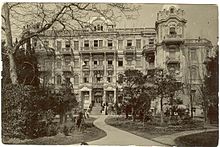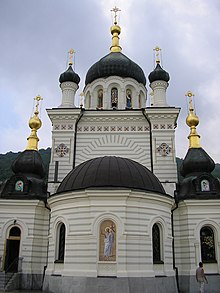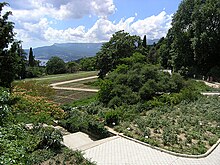Yalta: Difference between revisions
No edit summary |
m Added a few artworks to "Yalta in art" |
||
| Line 249: | Line 249: | ||
*{{flagicon|RUS}} [[Ulan Ude]], [[Russia]] |
*{{flagicon|RUS}} [[Ulan Ude]], [[Russia]] |
||
|} |
|} |
||
==Yalta in Art== |
|||
<gallery widths="190px"> |
|||
File:A_WARM_NOVEMBER_EVENING_IN_YALTA_(by_Eugene_Badusev).png| Eugene Badusev. "A warm November evening in Yalta" (2013) |
|||
File:YALTA._WALKING_DOWN_MORSKAYA_STREET_(by_Eugene_Badusev).png| Eugene Badusev. "Yalta. Walking down Morskaya Street" (2013) |
|||
File:Yalta_Yahts_(by_Eugene_Badusev).png|Eugene Badusev. “Yalta Yahts” (2013) |
|||
File:YALTA_INCOGNITA_(by_Eugene_Badusev).png|Eugene Badusev. “Yalta Incognita” (2013) |
|||
YALTA._KIROV_ST._DRUNKEN_HOUSES_(by_Eugene_Badusev).png|Eugene Badusev. “Drunken Houses on Kirov Street in Yalta” (2013) |
|||
</gallery> |
|||
==See also== |
==See also== |
||
Revision as of 15:41, 11 January 2014
Yalta
Ялта | |
|---|---|
| Top of left:Swallow's Nest and Aurora Cliff, Top of right:Livadia Palace, Center:View of Mount Ai Petry and Naberezhna waterfront area, Bottom of left:Alexander Nevski Cathdral, Bottom of right:Yalta Intourist Hotel Top of left:Swallow's Nest and Aurora Cliff, Top of right:Livadia Palace, Center:View of Mount Ai Petry and Naberezhna waterfront area, Bottom of left:Alexander Nevski Cathdral, Bottom of right:Yalta Intourist Hotel | |
| Country | |
| Republic | |
| Region | Yalta municipality |
| Elevation | 40 m (130 ft) |
| Population | |
| • Total | 134 909 |
| Time zone | UTC+2 (EET) |
| • Summer (DST) | UTC+3 (EEST) |
| Postal code | 98600 — 98639 |
| Area code | +380-654 |
| Former name | Yalita (until the 15th century) |
| Website | official website |
Yalta (Ukrainian, Russian, and Crimean Tatar: Я́лта), is a resort city in Crimea, southern Ukraine, on the north coast of the Black Sea. The city is located on the site of an ancient Greek colony, said to have been founded by Greek sailors who were looking for a safe shore (γιαλός – yalos in Greek) on which to land. It is situated on a deep bay facing south towards the Black Sea, surrounded by wooded mountains. It has a warm humid subtropical climate with many vineyards and orchards in the vicinity.[1]
The term "The Greater Yalta" is used to designate a part of the Crimean southern coast spanning from Foros in the west to Gurzuf in the east and including the city of Yalta and multiple adjacent urban settlements.
History
12th-19th centuries
The existence of Yalta was first recorded in the 12th century by an Arab geographer, who described it as a Byzantine port and fishing settlement. It became part of a network of Genoese trading colonies on the Crimean coast in the 14th century, when it was known as Etalita or Galita. Crimea was captured by the Ottoman Empire in 1475, which made it a semi-independent subject territory under the rule of the Crimean Khanate but the southern coast with Yalta was under direct ottoman rule forming the Eyalet of Kefe (Feodosiya). Yalta was annexed by the Russian Empire in 1783, along with the rest of Crimea, sparking the Russo-Turkish War, 1787-1792. Prior to the annexation of the Crimea, the Crimean Greeks were moved to Mariupol in 1778; one of the villages they established nearby is also called Yalta.
In the 19th century, the town became a fashionable resort for the Russian aristocracy and gentry. Leo Tolstoy spent summers there and Anton Chekhov in 1898 bought a house (the White Dacha) here, where he lived till 1902; Yalta is the setting for Chekhov's short story, "The Lady with the Dog", and such prominent plays as The Three Sisters were written in Yalta. The town was also closely associated with royalty. In 1889 Tsar Alexander III finished construction of Massandra Palace a short distance to the north of Yalta and Nicholas II built the Livadia Palace south-west of the town in 1911.
In the 20th century

During the 20th century Yalta was the principal holiday resort of the Soviet Union. In 1920, Vladimir Lenin issued a decree "On the Use of Crimea for the Medical Treatment of the Working People" which endorsed the region's transformation from a fairly exclusive resort area into a recreation facility for tired proletarians. Numerous workers' sanatoria were constructed in and around Yalta. There were, in fact, few other places that Soviet citizens could come for a seaside holiday, as foreign travel was forbidden to all but a handful. The Soviet elite also came to Yalta; the Soviet dictator Joseph Stalin used the Massandra Palace as his summer residence.
The town came to worldwide attention in 1945 when the Yalta Conference between the "Big Three" powers - the Soviet Union, the United States and the United Kingdom - was held at the Livadia Palace.
Modern Yalta
Following the dissolution of the Soviet Union in 1991, Yalta has struggled economically. Many of the nouveaux riches started going to other European holiday resorts, now that they had the freedom and money to travel; conversely, the impoverishment of many ex-Soviet citizens meant that they could no longer afford to go to Yalta. The town's transport links have been significantly reduced with the end of almost all passenger traffic by sea (on conditions for 2009 sea passenger lines return to Yalta. New line Yalta - Novorossiysk (Russia) is operating in July and August. + line Yalta - Sinop (Turkey)[citation needed] ). The longest trolleybus line in Europe goes from the train station in Simferopol to Yalta (almost 90 km). Yalta is really overcrowded in high season (July–August) and prices for accommodation are very high. Most of the tourists here are from countries of the former Soviet Union. Foreigners (this would be approximately 7% to the total number of tourists visiting Yalta) are mostly from Europe and United States.
Yalta has a beautiful embankment along the Black Sea. People can be seen strolling there all seasons of the year, and it also serves as a place to gather and talk, to see and be seen. There are several beaches to the left and right of the embankment. The town has a movie theater, drama theater, plenty of restaurants, and an open-air market.
Two beaches in Yalta are Blue Flag beaches since May 2010, these were the first beaches (with two beaches in Yevpatoria) to be awarded a Blue Flag in a CIS memberstate.[2]
Main sights


Famous attractions within or near Yalta are:
- Yalta's Sea Promenade (Naberezhnaya), housing many attractions and being recently renovated (2003–2004)
- Armenian Church, built by V. Surenyants
- A Roman Catholic Church built by N. Krasnov, a famous Russian architect
- Yalta's cable car, taking visitors to the Darsan hill, from which one can see Yalta's shoreline
- Renovated Hotel Taurica, the first hotel in the former Russian Empire with elevators
- Alexander Nevsky Cathedral, constructed by the architect Krasnov, who also constructed the Livadia Palace and the architect P. Terebenyov
- Former main building of the Ministry of Defence hotel, built in the style of a Gothic castle
- Palace of Bukhara Emir
- Yalta's Zoo
- Yalta's Aquarium, housing small dolphins
- Park-museum Polyana Skazok (Glade of Fairytales)
- White Dacha - House-museum of Anton Chekhov
- House-museum of Lesya Ukrainka
- House with Caryatids, where the composer A. Spendiarov lived
- Yalta Hotel Complex
Moreover, Yalta's suburbs contain:
- Foros Church
- Nikitsky Botanical Garden (Nikita)
- Livadia Palace (Livadiya)
- Organ hall in Livadiya
- Massandra Palace (Massandra)
- Massandra Winery and Vaults
- International children's centre of Artek(Gurzuf)
- Ai-Petri Mountain (1233 metres high, with a cable car traveling to and from the mountain)
- Alupka Palace
- Swallow's Nest castle near Gaspra.
- Tsar's Path hiking trail
Climate
As Yalta lies to the south of the Crimean Mountains and within an amphitheatre of hills, the climate is very mild. Yalta has a humid subtropical climate (Köppen climate classification: Cfa) that closely borders on a mediterranean climate.[1] In February, the average temperature reaches 4 °C (39 °F). Snow is rare and what snow the city does receive thaws quickly. In July, the average temperature reaches 24 °C (75 °F). The average annual precipitation is 612 millimetres (24.1 in), most of it being concentrated in the colder months. The sun shines approximately 2,169 hours per year. Since the city is located on the shore of the Black Sea, the weather rarely becomes extremely hot due to the cool sea breezes. The average annual temperature for Yalta is +13 C (56 F).
| Climate data for Yalta, 1981-2010 normals | |||||||||||||
|---|---|---|---|---|---|---|---|---|---|---|---|---|---|
| Month | Jan | Feb | Mar | Apr | May | Jun | Jul | Aug | Sep | Oct | Nov | Dec | Year |
| Record high °C (°F) | 17.8 (64.0) |
19.0 (66.2) |
27.8 (82.0) |
28.5 (83.3) |
33.0 (91.4) |
34.2 (93.6) |
39.1 (102.4) |
39.1 (102.4) |
35.0 (95.0) |
31.5 (88.7) |
25.3 (77.5) |
22.8 (73.0) |
39.1 (102.4) |
| Mean daily maximum °C (°F) | 7.1 (44.8) |
7.1 (44.8) |
9.5 (49.1) |
14.4 (57.9) |
19.8 (67.6) |
24.7 (76.5) |
28.2 (82.8) |
28.4 (83.1) |
23.4 (74.1) |
17.8 (64.0) |
12.4 (54.3) |
8.6 (47.5) |
16.8 (62.2) |
| Daily mean °C (°F) | 4.4 (39.9) |
4.0 (39.2) |
6.1 (43.0) |
10.7 (51.3) |
15.8 (60.4) |
20.6 (69.1) |
24.1 (75.4) |
24.4 (75.9) |
19.3 (66.7) |
14.2 (57.6) |
9.2 (48.6) |
5.9 (42.6) |
13.2 (55.8) |
| Mean daily minimum °C (°F) | 2.3 (36.1) |
1.6 (34.9) |
3.5 (38.3) |
7.7 (45.9) |
12.6 (54.7) |
17.2 (63.0) |
20.3 (68.5) |
20.5 (68.9) |
15.9 (60.6) |
11.2 (52.2) |
6.7 (44.1) |
3.7 (38.7) |
10.3 (50.5) |
| Record low °C (°F) | −12.2 (10.0) |
−12.3 (9.9) |
−7.3 (18.9) |
−3.8 (25.2) |
2.8 (37.0) |
7.8 (46.0) |
12.2 (54.0) |
8.9 (48.0) |
3.9 (39.0) |
−1.1 (30.0) |
−8.9 (16.0) |
−7.4 (18.7) |
−12.3 (9.9) |
| Average precipitation mm (inches) | 76 (3.0) |
60 (2.4) |
51 (2.0) |
33 (1.3) |
34 (1.3) |
36 (1.4) |
31 (1.2) |
46 (1.8) |
41 (1.6) |
53 (2.1) |
68 (2.7) |
83 (3.3) |
612 (24.1) |
| Average precipitation days | 11 | 9 | 10 | 10 | 9 | 9 | 6 | 6 | 8 | 9 | 10 | 12 | 109 |
| Mean monthly sunshine hours | 74.4 | 81.2 | 136.4 | 180.0 | 235.6 | 285.0 | 316.2 | 291.4 | 234.0 | 167.4 | 99.0 | 68.2 | 2,168.8 |
| Source 1: pogoda.ru.net[3] | |||||||||||||
| Source 2: Hong Kong Observatory[4] for data of sunshine hours | |||||||||||||
Demographics
As of the Ukrainian Census conducted on January 1, 2001, the population of Yalta is 80,500. The main ethnic groups of Yalta are: Russians — 65.5%, Ukrainians — 25.7%, Belarusians — 1.6%, Crimean Tatars — 1.3%.[5] The absolutely predominant language in the streets of the city is Russian. This total number does not comprise the population of neighboring villages and small towns. The metropolitan area population is about 139,500.
International relations
Twin towns - sister cities
Yalta is twinned with the following cities:
Yalta in Art
-
Eugene Badusev. "A warm November evening in Yalta" (2013)
-
Eugene Badusev. "Yalta. Walking down Morskaya Street" (2013)
-
Eugene Badusev. “Yalta Yahts” (2013)
-
Eugene Badusev. “Yalta Incognita” (2013)
-
Eugene Badusev. “Drunken Houses on Kirov Street in Yalta” (2013)
See also
References
This article needs additional citations for verification. (June 2009) |
- ^ a b Kottek, M. (2006). "World Map of the Köppen-Geiger climate classification updated" (PDF). Meteorol. Z. 15 (3): 259–263. doi:10.1127/0941-2948/2006/0130. Retrieved 28 August 2012.
{{cite journal}}: Unknown parameter|coauthors=ignored (|author=suggested) (help) - ^ Four beaches in Crimea receive international certificates of cleanliness, Kyiv Post (May 12, 2010)
- ^ "Pogoda.ru.net". Weather and Climate (in Russian). Retrieved 2012-04-21.
- ^ Climatological Information for Jalta, Ukraine - Hong Kong Observatory
- ^ Central Statistical Office of AR Crimea, see «Ялта», column №3.
- ^ http://www.acapulco.gob.mx/sistercities/index.php?id=247
- ^ http://es.db-city.com/M%C3%A9xico--Guerrero--Acapulco-de-Ju%C3%A1rez
- ^ "Batumi - Twin Towns & Sister Cities". Batumi City Hall. Archived from the original on 2012-05-04. Retrieved 2013-08-10.
- ^ "Villes jumelées avec la Ville de Nice" (in French). Ville de Nice. Retrieved 2013-06-24.
External links
 Media related to Category:Yalta at Wikimedia Commons
Media related to Category:Yalta at Wikimedia Commons




